Taxation Law Assignment: Income Tax, Deductions, and Residency
VerifiedAdded on 2022/09/18
|17
|3715
|24
Homework Assignment
AI Summary
This taxation law assignment is divided into two parts. Part A presents a case study involving Rachel, a CEO, and her tax residency status in Australia. The analysis considers her domicile, the 183-day rule, and the resides test, referencing relevant legislation such as the ITAA 1936 and case law. Part B comprises a memo addressing an objection to Julie Banks' amended tax assessment. The memo examines assessable income, focusing on the timing of income recognition and the application of the ITAA 1997. It further evaluates allowable deductions, including expenses related to Facebook sales and clothing, citing legal precedents like McNeil v FCT and Mansfield v FCT to support the arguments. The assignment meticulously applies legal principles to provide reasoned conclusions on the taxation of both income and deductions.
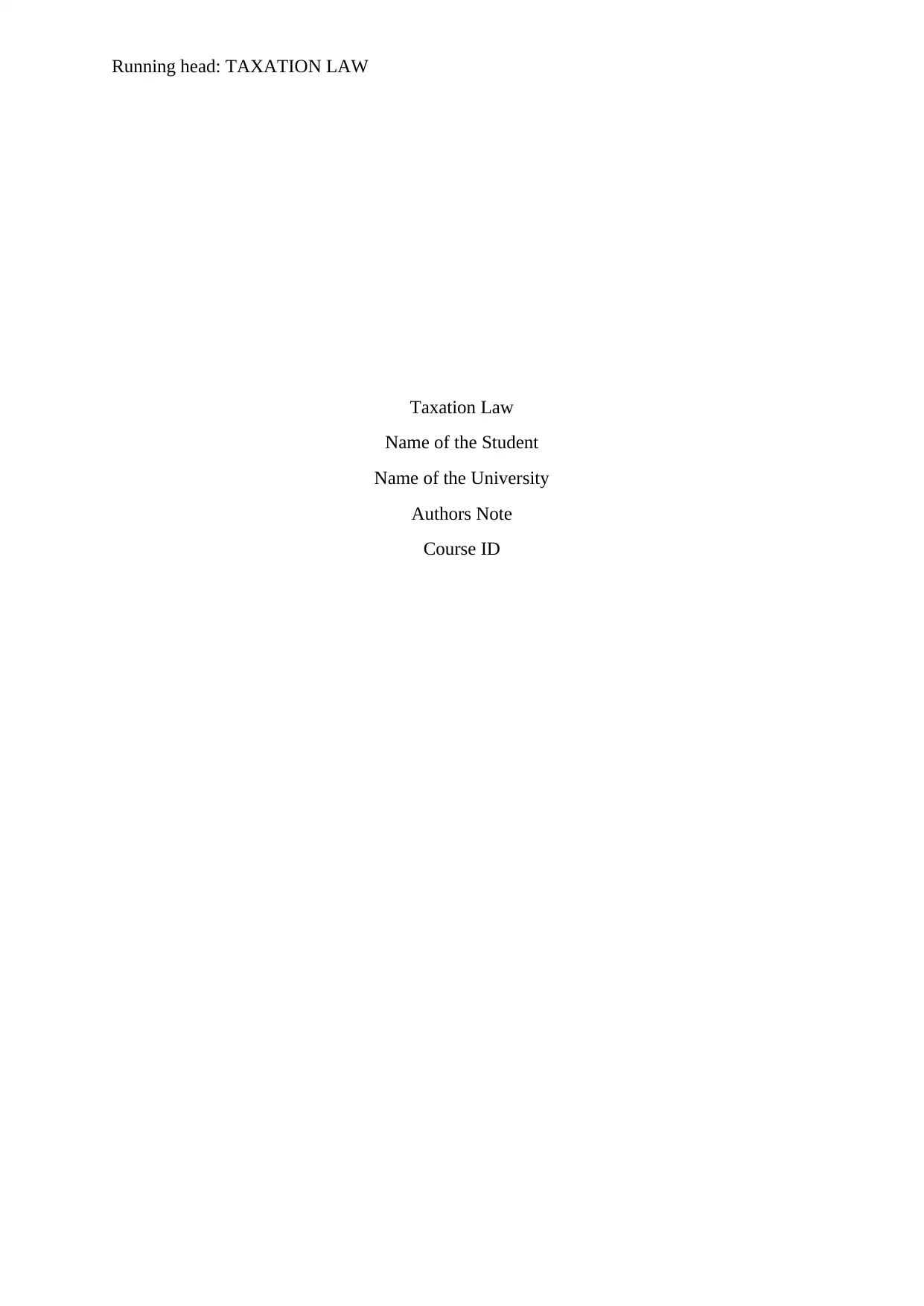
Running head: TAXATION LAW
Taxation Law
Name of the Student
Name of the University
Authors Note
Course ID
Taxation Law
Name of the Student
Name of the University
Authors Note
Course ID
Paraphrase This Document
Need a fresh take? Get an instant paraphrase of this document with our AI Paraphraser
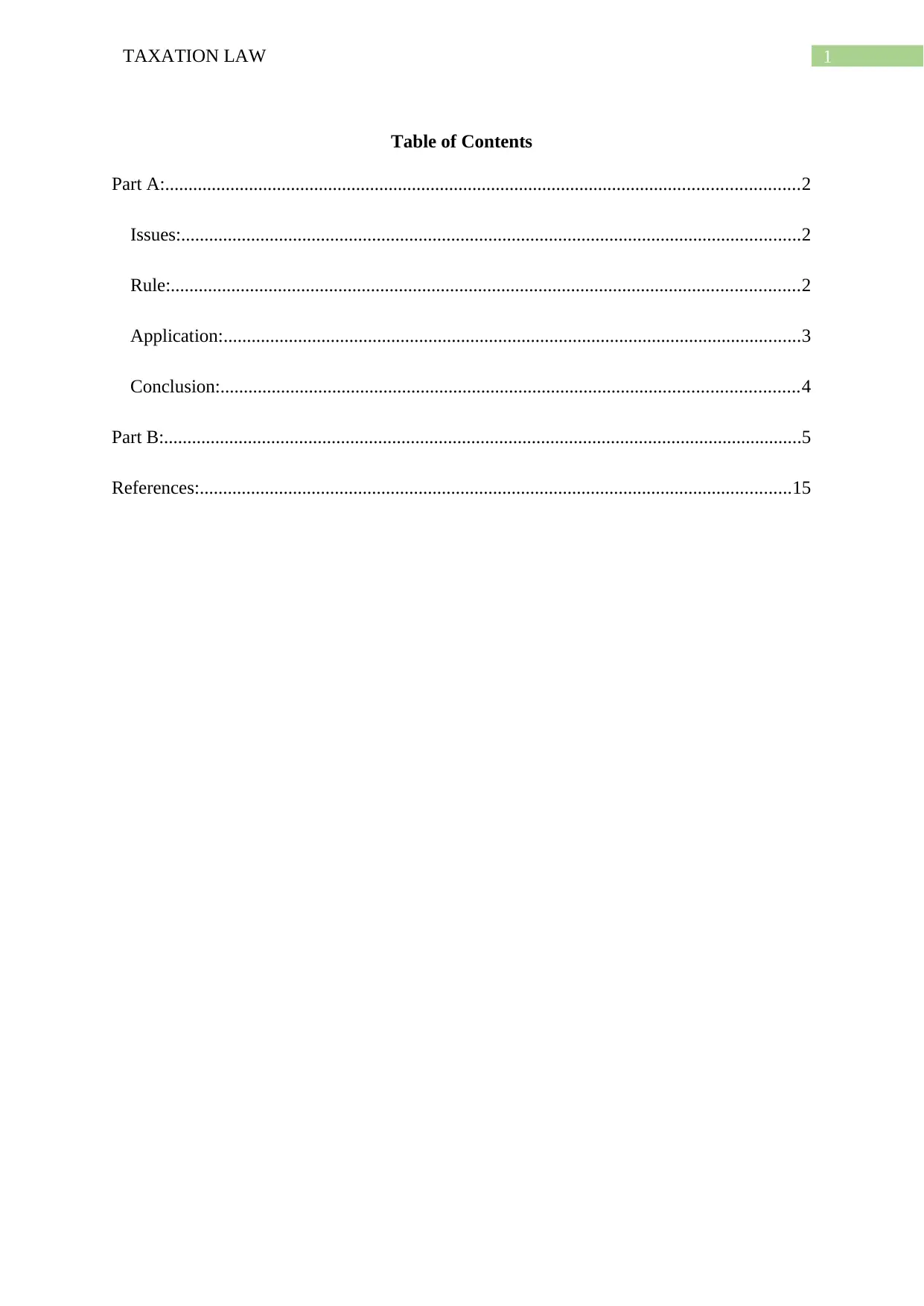
1TAXATION LAW
Table of Contents
Part A:........................................................................................................................................2
Issues:.....................................................................................................................................2
Rule:.......................................................................................................................................2
Application:............................................................................................................................3
Conclusion:............................................................................................................................4
Part B:.........................................................................................................................................5
References:...............................................................................................................................15
Table of Contents
Part A:........................................................................................................................................2
Issues:.....................................................................................................................................2
Rule:.......................................................................................................................................2
Application:............................................................................................................................3
Conclusion:............................................................................................................................4
Part B:.........................................................................................................................................5
References:...............................................................................................................................15
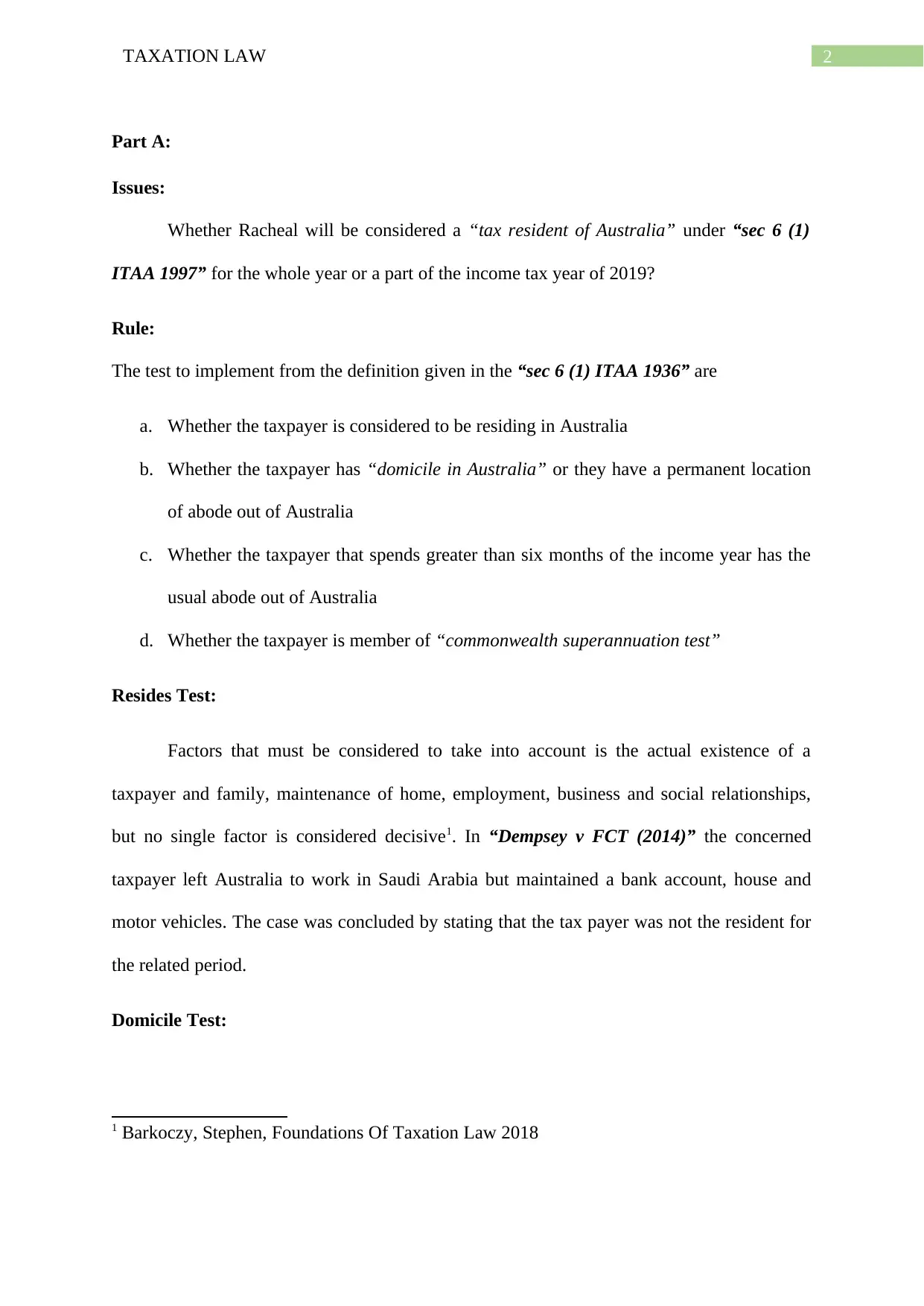
2TAXATION LAW
Part A:
Issues:
Whether Racheal will be considered a “tax resident of Australia” under “sec 6 (1)
ITAA 1997” for the whole year or a part of the income tax year of 2019?
Rule:
The test to implement from the definition given in the “sec 6 (1) ITAA 1936” are
a. Whether the taxpayer is considered to be residing in Australia
b. Whether the taxpayer has “domicile in Australia” or they have a permanent location
of abode out of Australia
c. Whether the taxpayer that spends greater than six months of the income year has the
usual abode out of Australia
d. Whether the taxpayer is member of “commonwealth superannuation test”
Resides Test:
Factors that must be considered to take into account is the actual existence of a
taxpayer and family, maintenance of home, employment, business and social relationships,
but no single factor is considered decisive1. In “Dempsey v FCT (2014)” the concerned
taxpayer left Australia to work in Saudi Arabia but maintained a bank account, house and
motor vehicles. The case was concluded by stating that the tax payer was not the resident for
the related period.
Domicile Test:
1 Barkoczy, Stephen, Foundations Of Taxation Law 2018
Part A:
Issues:
Whether Racheal will be considered a “tax resident of Australia” under “sec 6 (1)
ITAA 1997” for the whole year or a part of the income tax year of 2019?
Rule:
The test to implement from the definition given in the “sec 6 (1) ITAA 1936” are
a. Whether the taxpayer is considered to be residing in Australia
b. Whether the taxpayer has “domicile in Australia” or they have a permanent location
of abode out of Australia
c. Whether the taxpayer that spends greater than six months of the income year has the
usual abode out of Australia
d. Whether the taxpayer is member of “commonwealth superannuation test”
Resides Test:
Factors that must be considered to take into account is the actual existence of a
taxpayer and family, maintenance of home, employment, business and social relationships,
but no single factor is considered decisive1. In “Dempsey v FCT (2014)” the concerned
taxpayer left Australia to work in Saudi Arabia but maintained a bank account, house and
motor vehicles. The case was concluded by stating that the tax payer was not the resident for
the related period.
Domicile Test:
1 Barkoczy, Stephen, Foundations Of Taxation Law 2018
⊘ This is a preview!⊘
Do you want full access?
Subscribe today to unlock all pages.

Trusted by 1+ million students worldwide
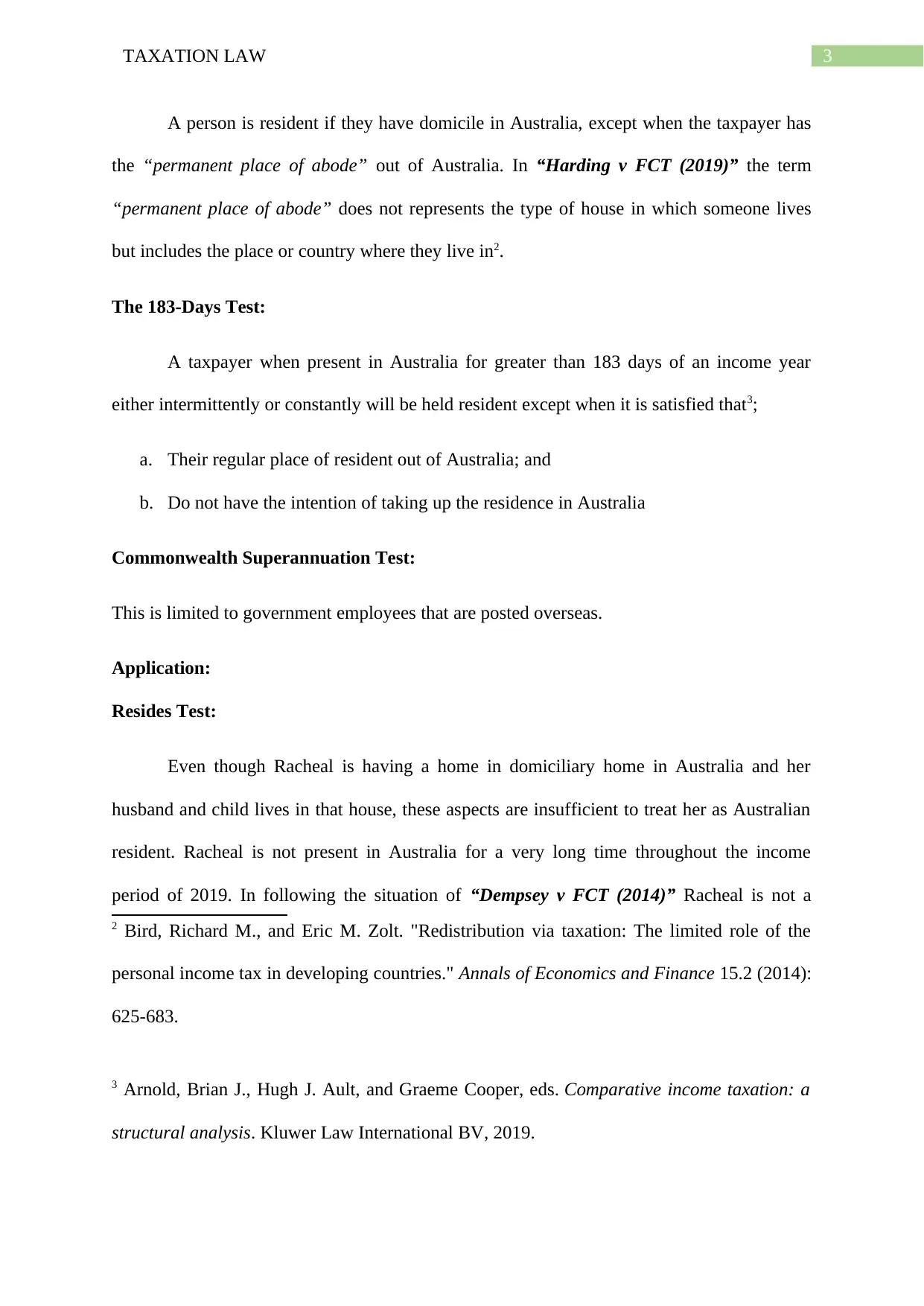
3TAXATION LAW
A person is resident if they have domicile in Australia, except when the taxpayer has
the “permanent place of abode” out of Australia. In “Harding v FCT (2019)” the term
“permanent place of abode” does not represents the type of house in which someone lives
but includes the place or country where they live in2.
The 183-Days Test:
A taxpayer when present in Australia for greater than 183 days of an income year
either intermittently or constantly will be held resident except when it is satisfied that3;
a. Their regular place of resident out of Australia; and
b. Do not have the intention of taking up the residence in Australia
Commonwealth Superannuation Test:
This is limited to government employees that are posted overseas.
Application:
Resides Test:
Even though Racheal is having a home in domiciliary home in Australia and her
husband and child lives in that house, these aspects are insufficient to treat her as Australian
resident. Racheal is not present in Australia for a very long time throughout the income
period of 2019. In following the situation of “Dempsey v FCT (2014)” Racheal is not a
2 Bird, Richard M., and Eric M. Zolt. "Redistribution via taxation: The limited role of the
personal income tax in developing countries." Annals of Economics and Finance 15.2 (2014):
625-683.
3 Arnold, Brian J., Hugh J. Ault, and Graeme Cooper, eds. Comparative income taxation: a
structural analysis. Kluwer Law International BV, 2019.
A person is resident if they have domicile in Australia, except when the taxpayer has
the “permanent place of abode” out of Australia. In “Harding v FCT (2019)” the term
“permanent place of abode” does not represents the type of house in which someone lives
but includes the place or country where they live in2.
The 183-Days Test:
A taxpayer when present in Australia for greater than 183 days of an income year
either intermittently or constantly will be held resident except when it is satisfied that3;
a. Their regular place of resident out of Australia; and
b. Do not have the intention of taking up the residence in Australia
Commonwealth Superannuation Test:
This is limited to government employees that are posted overseas.
Application:
Resides Test:
Even though Racheal is having a home in domiciliary home in Australia and her
husband and child lives in that house, these aspects are insufficient to treat her as Australian
resident. Racheal is not present in Australia for a very long time throughout the income
period of 2019. In following the situation of “Dempsey v FCT (2014)” Racheal is not a
2 Bird, Richard M., and Eric M. Zolt. "Redistribution via taxation: The limited role of the
personal income tax in developing countries." Annals of Economics and Finance 15.2 (2014):
625-683.
3 Arnold, Brian J., Hugh J. Ault, and Graeme Cooper, eds. Comparative income taxation: a
structural analysis. Kluwer Law International BV, 2019.
Paraphrase This Document
Need a fresh take? Get an instant paraphrase of this document with our AI Paraphraser
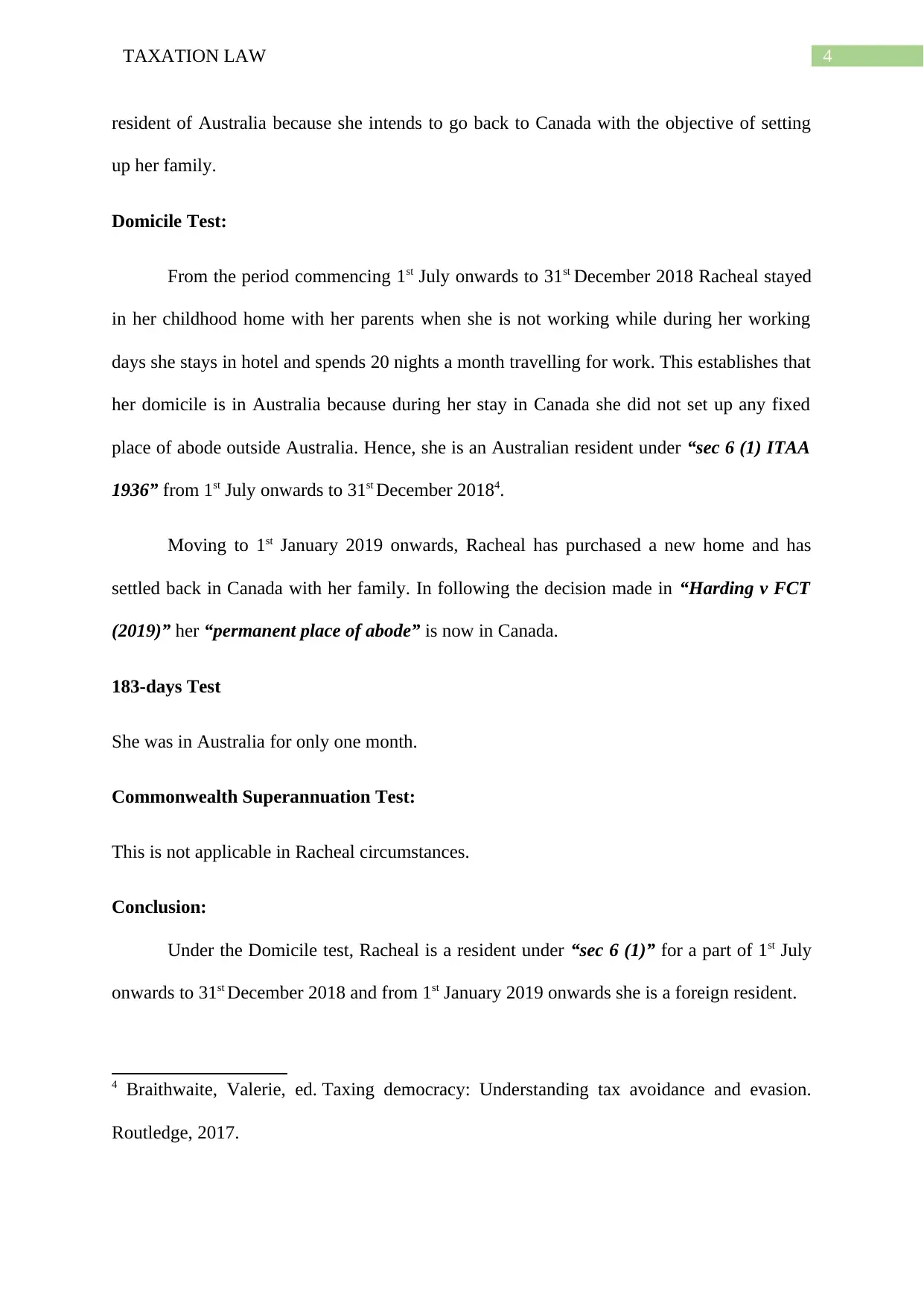
4TAXATION LAW
resident of Australia because she intends to go back to Canada with the objective of setting
up her family.
Domicile Test:
From the period commencing 1st July onwards to 31st December 2018 Racheal stayed
in her childhood home with her parents when she is not working while during her working
days she stays in hotel and spends 20 nights a month travelling for work. This establishes that
her domicile is in Australia because during her stay in Canada she did not set up any fixed
place of abode outside Australia. Hence, she is an Australian resident under “sec 6 (1) ITAA
1936” from 1st July onwards to 31st December 20184.
Moving to 1st January 2019 onwards, Racheal has purchased a new home and has
settled back in Canada with her family. In following the decision made in “Harding v FCT
(2019)” her “permanent place of abode” is now in Canada.
183-days Test
She was in Australia for only one month.
Commonwealth Superannuation Test:
This is not applicable in Racheal circumstances.
Conclusion:
Under the Domicile test, Racheal is a resident under “sec 6 (1)” for a part of 1st July
onwards to 31st December 2018 and from 1st January 2019 onwards she is a foreign resident.
4 Braithwaite, Valerie, ed. Taxing democracy: Understanding tax avoidance and evasion.
Routledge, 2017.
resident of Australia because she intends to go back to Canada with the objective of setting
up her family.
Domicile Test:
From the period commencing 1st July onwards to 31st December 2018 Racheal stayed
in her childhood home with her parents when she is not working while during her working
days she stays in hotel and spends 20 nights a month travelling for work. This establishes that
her domicile is in Australia because during her stay in Canada she did not set up any fixed
place of abode outside Australia. Hence, she is an Australian resident under “sec 6 (1) ITAA
1936” from 1st July onwards to 31st December 20184.
Moving to 1st January 2019 onwards, Racheal has purchased a new home and has
settled back in Canada with her family. In following the decision made in “Harding v FCT
(2019)” her “permanent place of abode” is now in Canada.
183-days Test
She was in Australia for only one month.
Commonwealth Superannuation Test:
This is not applicable in Racheal circumstances.
Conclusion:
Under the Domicile test, Racheal is a resident under “sec 6 (1)” for a part of 1st July
onwards to 31st December 2018 and from 1st January 2019 onwards she is a foreign resident.
4 Braithwaite, Valerie, ed. Taxing democracy: Understanding tax avoidance and evasion.
Routledge, 2017.
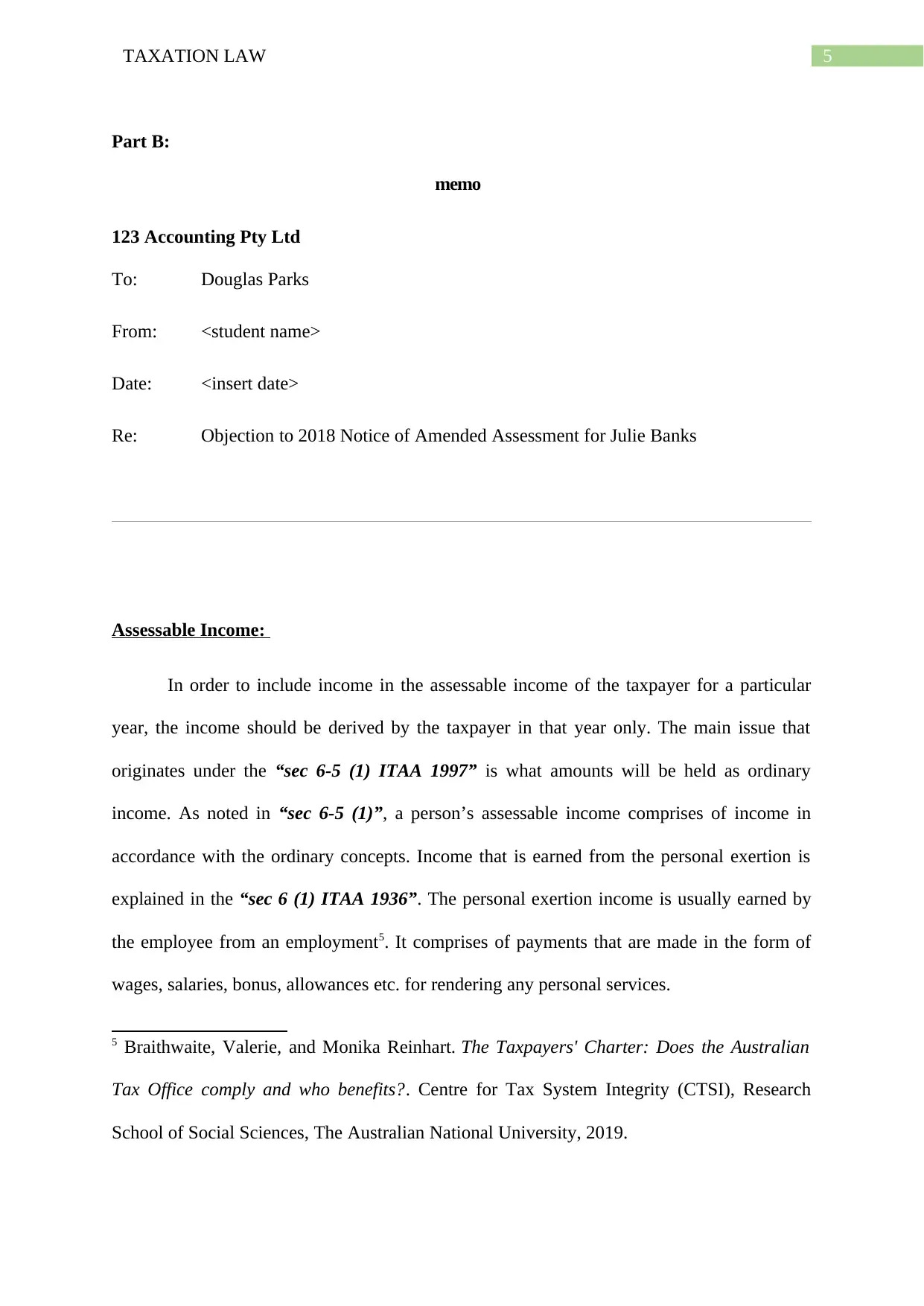
5TAXATION LAW
Part B:
memo
123 Accounting Pty Ltd
To: Douglas Parks
From: <student name>
Date: <insert date>
Re: Objection to 2018 Notice of Amended Assessment for Julie Banks
Assessable Income:
In order to include income in the assessable income of the taxpayer for a particular
year, the income should be derived by the taxpayer in that year only. The main issue that
originates under the “sec 6-5 (1) ITAA 1997” is what amounts will be held as ordinary
income. As noted in “sec 6-5 (1)”, a person’s assessable income comprises of income in
accordance with the ordinary concepts. Income that is earned from the personal exertion is
explained in the “sec 6 (1) ITAA 1936”. The personal exertion income is usually earned by
the employee from an employment5. It comprises of payments that are made in the form of
wages, salaries, bonus, allowances etc. for rendering any personal services.
5 Braithwaite, Valerie, and Monika Reinhart. The Taxpayers' Charter: Does the Australian
Tax Office comply and who benefits?. Centre for Tax System Integrity (CTSI), Research
School of Social Sciences, The Australian National University, 2019.
Part B:
memo
123 Accounting Pty Ltd
To: Douglas Parks
From: <student name>
Date: <insert date>
Re: Objection to 2018 Notice of Amended Assessment for Julie Banks
Assessable Income:
In order to include income in the assessable income of the taxpayer for a particular
year, the income should be derived by the taxpayer in that year only. The main issue that
originates under the “sec 6-5 (1) ITAA 1997” is what amounts will be held as ordinary
income. As noted in “sec 6-5 (1)”, a person’s assessable income comprises of income in
accordance with the ordinary concepts. Income that is earned from the personal exertion is
explained in the “sec 6 (1) ITAA 1936”. The personal exertion income is usually earned by
the employee from an employment5. It comprises of payments that are made in the form of
wages, salaries, bonus, allowances etc. for rendering any personal services.
5 Braithwaite, Valerie, and Monika Reinhart. The Taxpayers' Charter: Does the Australian
Tax Office comply and who benefits?. Centre for Tax System Integrity (CTSI), Research
School of Social Sciences, The Australian National University, 2019.
⊘ This is a preview!⊘
Do you want full access?
Subscribe today to unlock all pages.

Trusted by 1+ million students worldwide
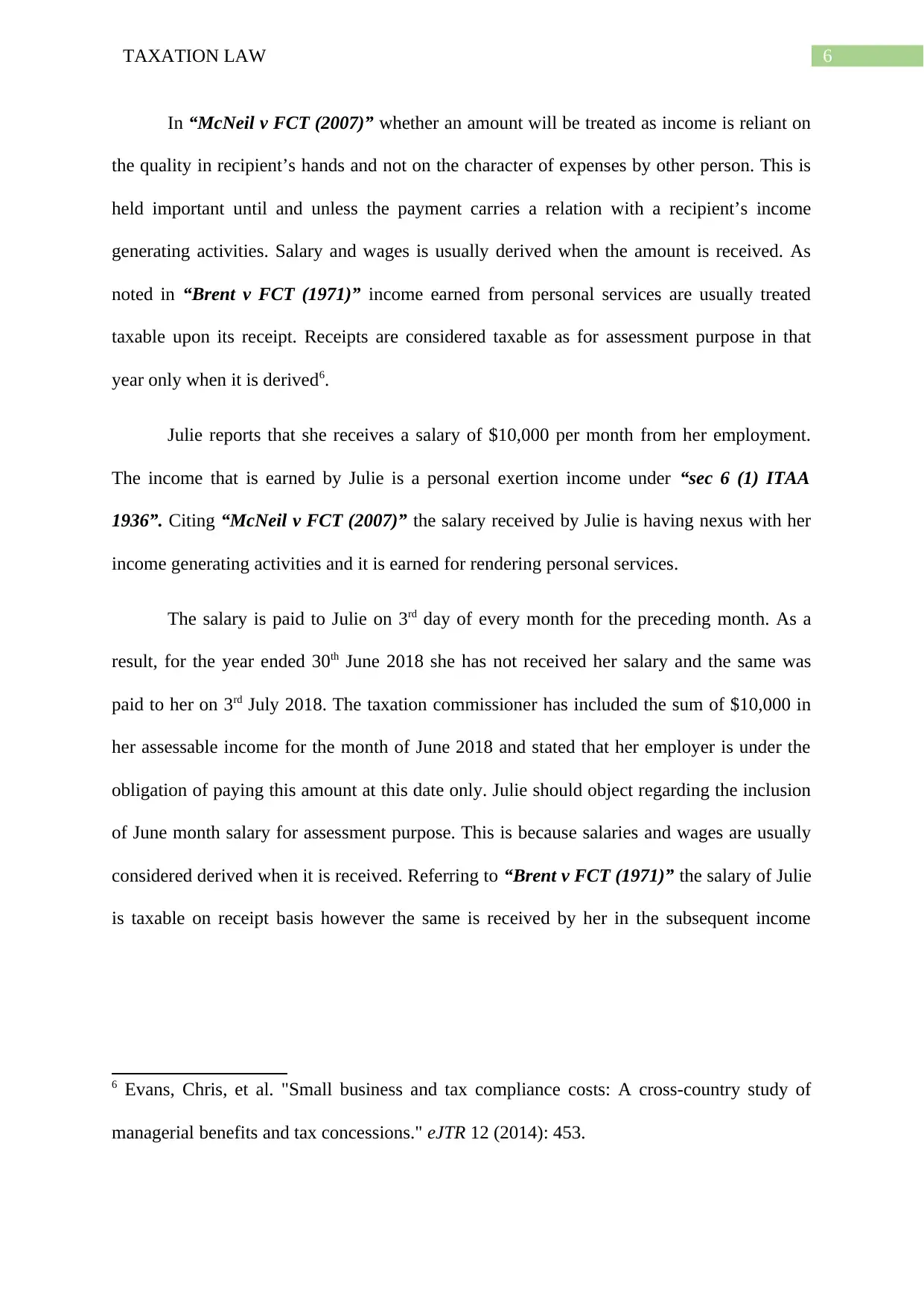
6TAXATION LAW
In “McNeil v FCT (2007)” whether an amount will be treated as income is reliant on
the quality in recipient’s hands and not on the character of expenses by other person. This is
held important until and unless the payment carries a relation with a recipient’s income
generating activities. Salary and wages is usually derived when the amount is received. As
noted in “Brent v FCT (1971)” income earned from personal services are usually treated
taxable upon its receipt. Receipts are considered taxable as for assessment purpose in that
year only when it is derived6.
Julie reports that she receives a salary of $10,000 per month from her employment.
The income that is earned by Julie is a personal exertion income under “sec 6 (1) ITAA
1936”. Citing “McNeil v FCT (2007)” the salary received by Julie is having nexus with her
income generating activities and it is earned for rendering personal services.
The salary is paid to Julie on 3rd day of every month for the preceding month. As a
result, for the year ended 30th June 2018 she has not received her salary and the same was
paid to her on 3rd July 2018. The taxation commissioner has included the sum of $10,000 in
her assessable income for the month of June 2018 and stated that her employer is under the
obligation of paying this amount at this date only. Julie should object regarding the inclusion
of June month salary for assessment purpose. This is because salaries and wages are usually
considered derived when it is received. Referring to “Brent v FCT (1971)” the salary of Julie
is taxable on receipt basis however the same is received by her in the subsequent income
6 Evans, Chris, et al. "Small business and tax compliance costs: A cross-country study of
managerial benefits and tax concessions." eJTR 12 (2014): 453.
In “McNeil v FCT (2007)” whether an amount will be treated as income is reliant on
the quality in recipient’s hands and not on the character of expenses by other person. This is
held important until and unless the payment carries a relation with a recipient’s income
generating activities. Salary and wages is usually derived when the amount is received. As
noted in “Brent v FCT (1971)” income earned from personal services are usually treated
taxable upon its receipt. Receipts are considered taxable as for assessment purpose in that
year only when it is derived6.
Julie reports that she receives a salary of $10,000 per month from her employment.
The income that is earned by Julie is a personal exertion income under “sec 6 (1) ITAA
1936”. Citing “McNeil v FCT (2007)” the salary received by Julie is having nexus with her
income generating activities and it is earned for rendering personal services.
The salary is paid to Julie on 3rd day of every month for the preceding month. As a
result, for the year ended 30th June 2018 she has not received her salary and the same was
paid to her on 3rd July 2018. The taxation commissioner has included the sum of $10,000 in
her assessable income for the month of June 2018 and stated that her employer is under the
obligation of paying this amount at this date only. Julie should object regarding the inclusion
of June month salary for assessment purpose. This is because salaries and wages are usually
considered derived when it is received. Referring to “Brent v FCT (1971)” the salary of Julie
is taxable on receipt basis however the same is received by her in the subsequent income
6 Evans, Chris, et al. "Small business and tax compliance costs: A cross-country study of
managerial benefits and tax concessions." eJTR 12 (2014): 453.
Paraphrase This Document
Need a fresh take? Get an instant paraphrase of this document with our AI Paraphraser
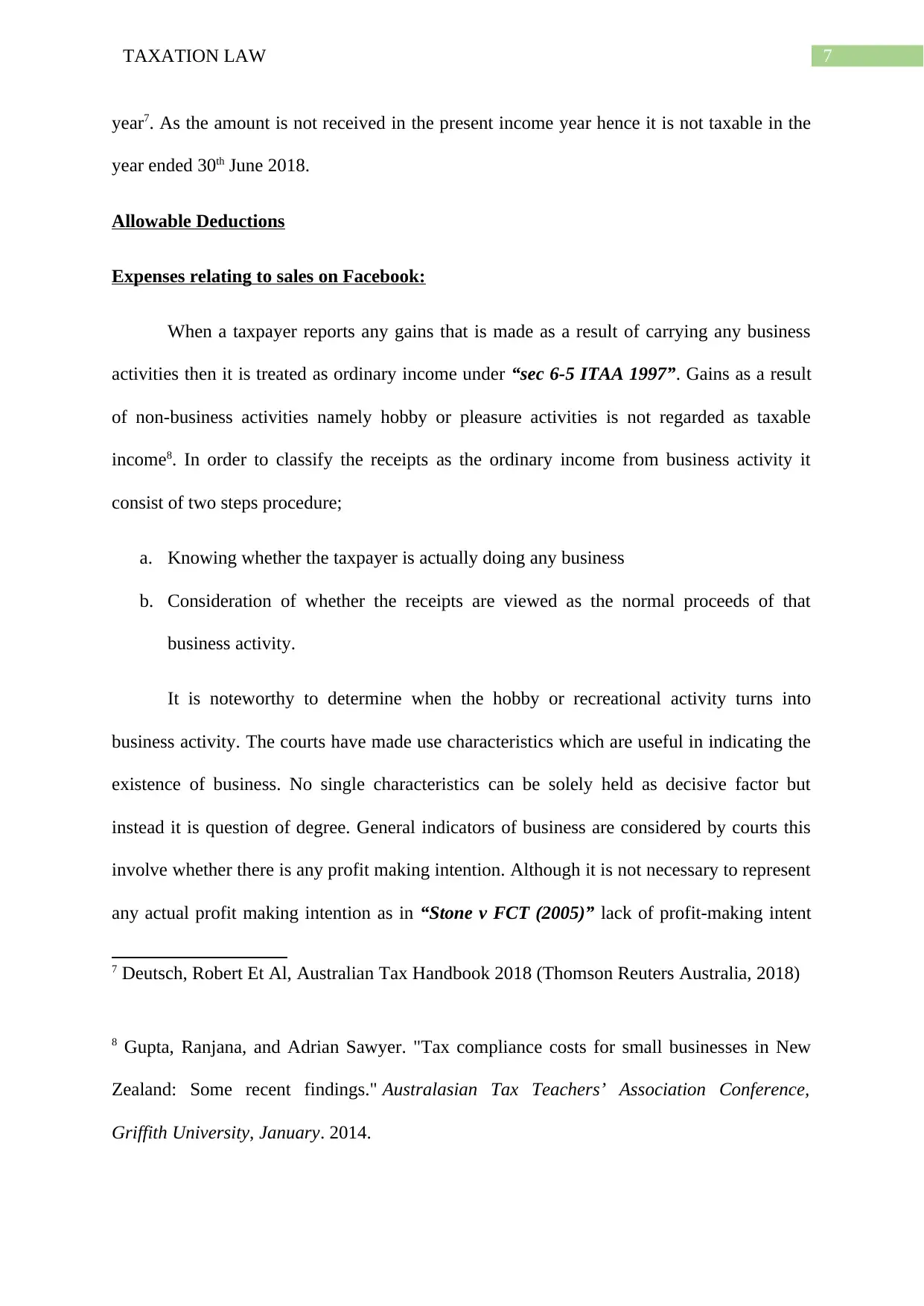
7TAXATION LAW
year7. As the amount is not received in the present income year hence it is not taxable in the
year ended 30th June 2018.
Allowable Deductions
Expenses relating to sales on Facebook:
When a taxpayer reports any gains that is made as a result of carrying any business
activities then it is treated as ordinary income under “sec 6-5 ITAA 1997”. Gains as a result
of non-business activities namely hobby or pleasure activities is not regarded as taxable
income8. In order to classify the receipts as the ordinary income from business activity it
consist of two steps procedure;
a. Knowing whether the taxpayer is actually doing any business
b. Consideration of whether the receipts are viewed as the normal proceeds of that
business activity.
It is noteworthy to determine when the hobby or recreational activity turns into
business activity. The courts have made use characteristics which are useful in indicating the
existence of business. No single characteristics can be solely held as decisive factor but
instead it is question of degree. General indicators of business are considered by courts this
involve whether there is any profit making intention. Although it is not necessary to represent
any actual profit making intention as in “Stone v FCT (2005)” lack of profit-making intent
7 Deutsch, Robert Et Al, Australian Tax Handbook 2018 (Thomson Reuters Australia, 2018)
8 Gupta, Ranjana, and Adrian Sawyer. "Tax compliance costs for small businesses in New
Zealand: Some recent findings." Australasian Tax Teachers’ Association Conference,
Griffith University, January. 2014.
year7. As the amount is not received in the present income year hence it is not taxable in the
year ended 30th June 2018.
Allowable Deductions
Expenses relating to sales on Facebook:
When a taxpayer reports any gains that is made as a result of carrying any business
activities then it is treated as ordinary income under “sec 6-5 ITAA 1997”. Gains as a result
of non-business activities namely hobby or pleasure activities is not regarded as taxable
income8. In order to classify the receipts as the ordinary income from business activity it
consist of two steps procedure;
a. Knowing whether the taxpayer is actually doing any business
b. Consideration of whether the receipts are viewed as the normal proceeds of that
business activity.
It is noteworthy to determine when the hobby or recreational activity turns into
business activity. The courts have made use characteristics which are useful in indicating the
existence of business. No single characteristics can be solely held as decisive factor but
instead it is question of degree. General indicators of business are considered by courts this
involve whether there is any profit making intention. Although it is not necessary to represent
any actual profit making intention as in “Stone v FCT (2005)” lack of profit-making intent
7 Deutsch, Robert Et Al, Australian Tax Handbook 2018 (Thomson Reuters Australia, 2018)
8 Gupta, Ranjana, and Adrian Sawyer. "Tax compliance costs for small businesses in New
Zealand: Some recent findings." Australasian Tax Teachers’ Association Conference,
Griffith University, January. 2014.
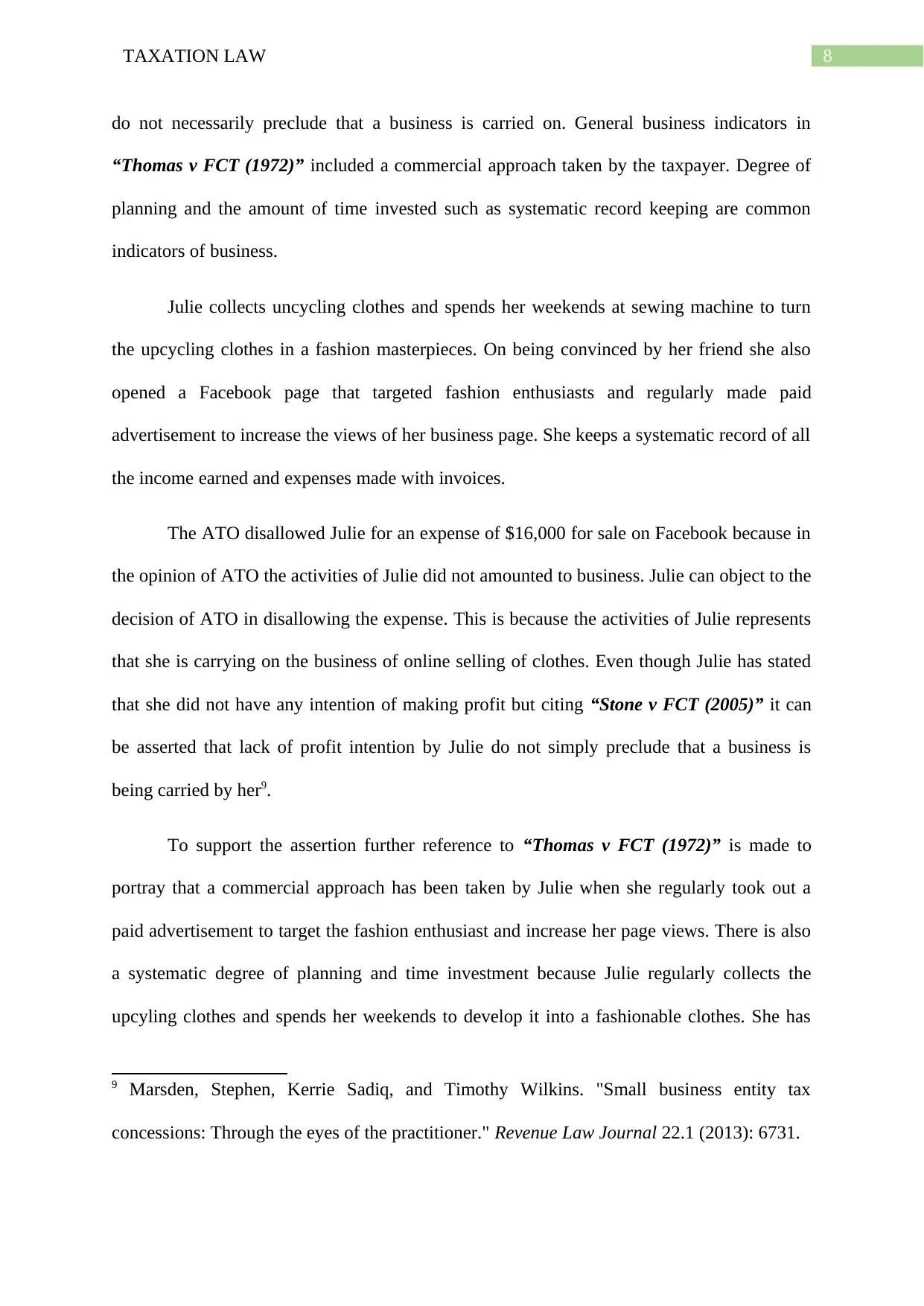
8TAXATION LAW
do not necessarily preclude that a business is carried on. General business indicators in
“Thomas v FCT (1972)” included a commercial approach taken by the taxpayer. Degree of
planning and the amount of time invested such as systematic record keeping are common
indicators of business.
Julie collects uncycling clothes and spends her weekends at sewing machine to turn
the upcycling clothes in a fashion masterpieces. On being convinced by her friend she also
opened a Facebook page that targeted fashion enthusiasts and regularly made paid
advertisement to increase the views of her business page. She keeps a systematic record of all
the income earned and expenses made with invoices.
The ATO disallowed Julie for an expense of $16,000 for sale on Facebook because in
the opinion of ATO the activities of Julie did not amounted to business. Julie can object to the
decision of ATO in disallowing the expense. This is because the activities of Julie represents
that she is carrying on the business of online selling of clothes. Even though Julie has stated
that she did not have any intention of making profit but citing “Stone v FCT (2005)” it can
be asserted that lack of profit intention by Julie do not simply preclude that a business is
being carried by her9.
To support the assertion further reference to “Thomas v FCT (1972)” is made to
portray that a commercial approach has been taken by Julie when she regularly took out a
paid advertisement to target the fashion enthusiast and increase her page views. There is also
a systematic degree of planning and time investment because Julie regularly collects the
upcyling clothes and spends her weekends to develop it into a fashionable clothes. She has
9 Marsden, Stephen, Kerrie Sadiq, and Timothy Wilkins. "Small business entity tax
concessions: Through the eyes of the practitioner." Revenue Law Journal 22.1 (2013): 6731.
do not necessarily preclude that a business is carried on. General business indicators in
“Thomas v FCT (1972)” included a commercial approach taken by the taxpayer. Degree of
planning and the amount of time invested such as systematic record keeping are common
indicators of business.
Julie collects uncycling clothes and spends her weekends at sewing machine to turn
the upcycling clothes in a fashion masterpieces. On being convinced by her friend she also
opened a Facebook page that targeted fashion enthusiasts and regularly made paid
advertisement to increase the views of her business page. She keeps a systematic record of all
the income earned and expenses made with invoices.
The ATO disallowed Julie for an expense of $16,000 for sale on Facebook because in
the opinion of ATO the activities of Julie did not amounted to business. Julie can object to the
decision of ATO in disallowing the expense. This is because the activities of Julie represents
that she is carrying on the business of online selling of clothes. Even though Julie has stated
that she did not have any intention of making profit but citing “Stone v FCT (2005)” it can
be asserted that lack of profit intention by Julie do not simply preclude that a business is
being carried by her9.
To support the assertion further reference to “Thomas v FCT (1972)” is made to
portray that a commercial approach has been taken by Julie when she regularly took out a
paid advertisement to target the fashion enthusiast and increase her page views. There is also
a systematic degree of planning and time investment because Julie regularly collects the
upcyling clothes and spends her weekends to develop it into a fashionable clothes. She has
9 Marsden, Stephen, Kerrie Sadiq, and Timothy Wilkins. "Small business entity tax
concessions: Through the eyes of the practitioner." Revenue Law Journal 22.1 (2013): 6731.
⊘ This is a preview!⊘
Do you want full access?
Subscribe today to unlock all pages.

Trusted by 1+ million students worldwide
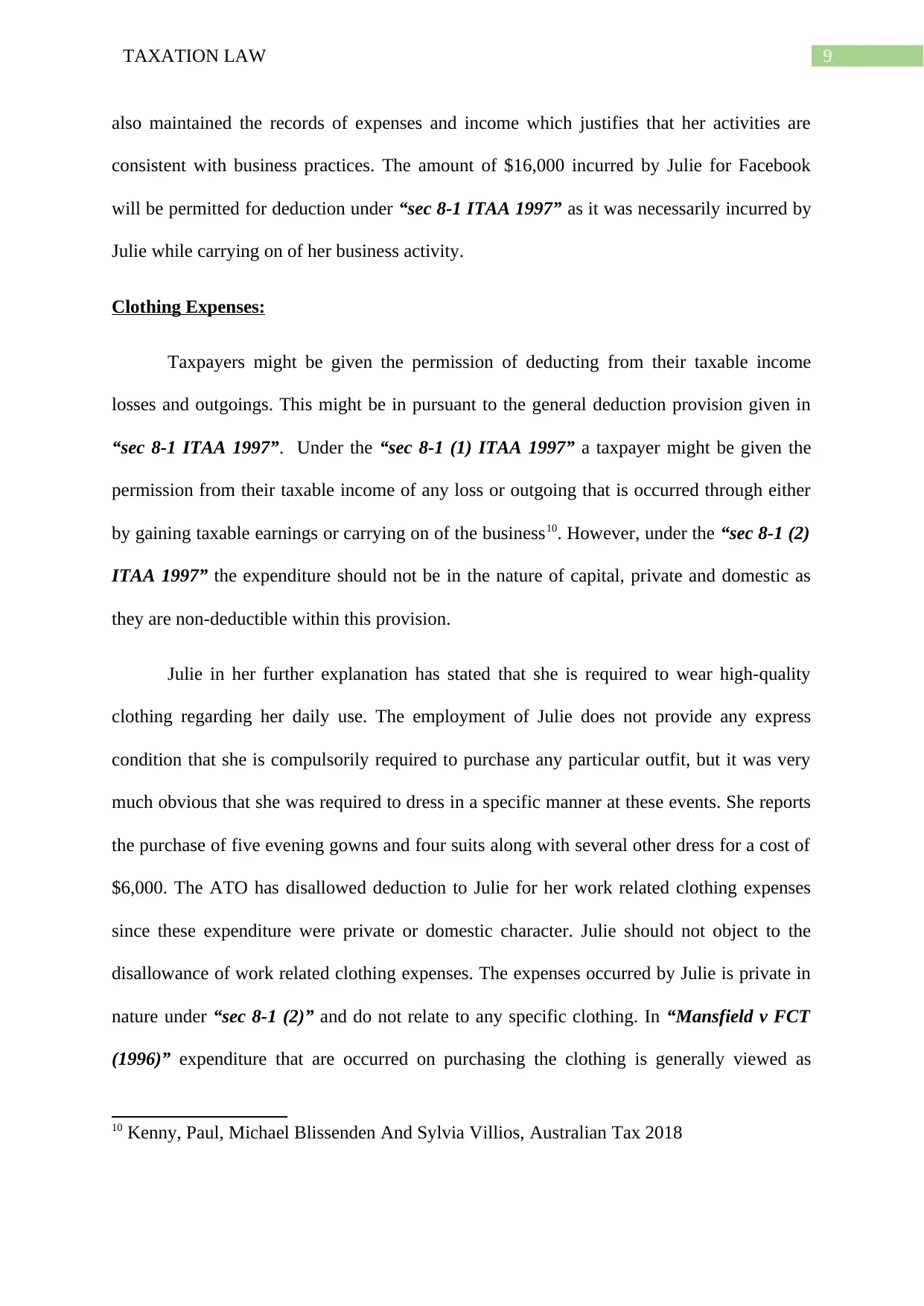
9TAXATION LAW
also maintained the records of expenses and income which justifies that her activities are
consistent with business practices. The amount of $16,000 incurred by Julie for Facebook
will be permitted for deduction under “sec 8-1 ITAA 1997” as it was necessarily incurred by
Julie while carrying on of her business activity.
Clothing Expenses:
Taxpayers might be given the permission of deducting from their taxable income
losses and outgoings. This might be in pursuant to the general deduction provision given in
“sec 8-1 ITAA 1997”. Under the “sec 8-1 (1) ITAA 1997” a taxpayer might be given the
permission from their taxable income of any loss or outgoing that is occurred through either
by gaining taxable earnings or carrying on of the business10. However, under the “sec 8-1 (2)
ITAA 1997” the expenditure should not be in the nature of capital, private and domestic as
they are non-deductible within this provision.
Julie in her further explanation has stated that she is required to wear high-quality
clothing regarding her daily use. The employment of Julie does not provide any express
condition that she is compulsorily required to purchase any particular outfit, but it was very
much obvious that she was required to dress in a specific manner at these events. She reports
the purchase of five evening gowns and four suits along with several other dress for a cost of
$6,000. The ATO has disallowed deduction to Julie for her work related clothing expenses
since these expenditure were private or domestic character. Julie should not object to the
disallowance of work related clothing expenses. The expenses occurred by Julie is private in
nature under “sec 8-1 (2)” and do not relate to any specific clothing. In “Mansfield v FCT
(1996)” expenditure that are occurred on purchasing the clothing is generally viewed as
10 Kenny, Paul, Michael Blissenden And Sylvia Villios, Australian Tax 2018
also maintained the records of expenses and income which justifies that her activities are
consistent with business practices. The amount of $16,000 incurred by Julie for Facebook
will be permitted for deduction under “sec 8-1 ITAA 1997” as it was necessarily incurred by
Julie while carrying on of her business activity.
Clothing Expenses:
Taxpayers might be given the permission of deducting from their taxable income
losses and outgoings. This might be in pursuant to the general deduction provision given in
“sec 8-1 ITAA 1997”. Under the “sec 8-1 (1) ITAA 1997” a taxpayer might be given the
permission from their taxable income of any loss or outgoing that is occurred through either
by gaining taxable earnings or carrying on of the business10. However, under the “sec 8-1 (2)
ITAA 1997” the expenditure should not be in the nature of capital, private and domestic as
they are non-deductible within this provision.
Julie in her further explanation has stated that she is required to wear high-quality
clothing regarding her daily use. The employment of Julie does not provide any express
condition that she is compulsorily required to purchase any particular outfit, but it was very
much obvious that she was required to dress in a specific manner at these events. She reports
the purchase of five evening gowns and four suits along with several other dress for a cost of
$6,000. The ATO has disallowed deduction to Julie for her work related clothing expenses
since these expenditure were private or domestic character. Julie should not object to the
disallowance of work related clothing expenses. The expenses occurred by Julie is private in
nature under “sec 8-1 (2)” and do not relate to any specific clothing. In “Mansfield v FCT
(1996)” expenditure that are occurred on purchasing the clothing is generally viewed as
10 Kenny, Paul, Michael Blissenden And Sylvia Villios, Australian Tax 2018
Paraphrase This Document
Need a fresh take? Get an instant paraphrase of this document with our AI Paraphraser
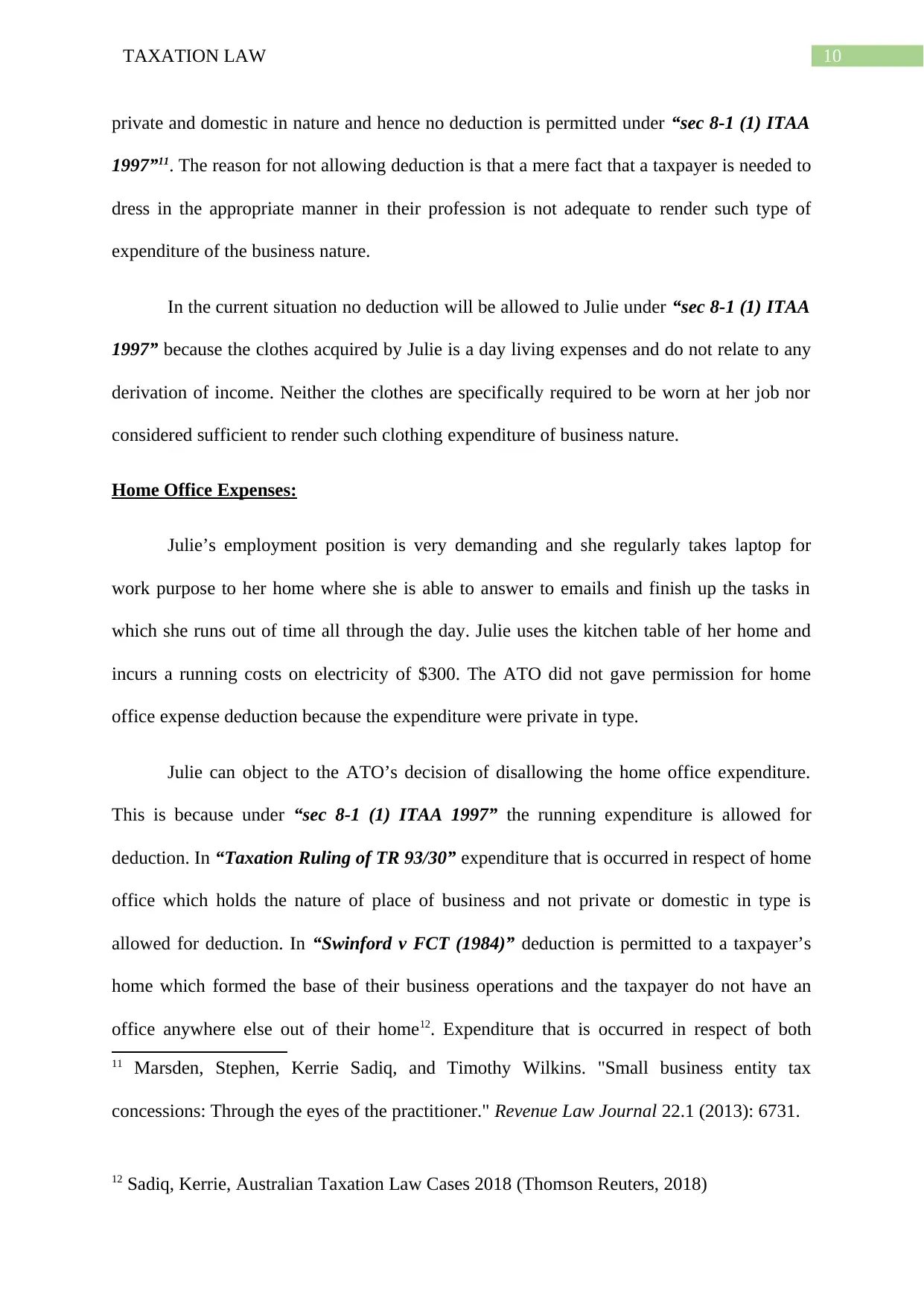
10TAXATION LAW
private and domestic in nature and hence no deduction is permitted under “sec 8-1 (1) ITAA
1997”11. The reason for not allowing deduction is that a mere fact that a taxpayer is needed to
dress in the appropriate manner in their profession is not adequate to render such type of
expenditure of the business nature.
In the current situation no deduction will be allowed to Julie under “sec 8-1 (1) ITAA
1997” because the clothes acquired by Julie is a day living expenses and do not relate to any
derivation of income. Neither the clothes are specifically required to be worn at her job nor
considered sufficient to render such clothing expenditure of business nature.
Home Office Expenses:
Julie’s employment position is very demanding and she regularly takes laptop for
work purpose to her home where she is able to answer to emails and finish up the tasks in
which she runs out of time all through the day. Julie uses the kitchen table of her home and
incurs a running costs on electricity of $300. The ATO did not gave permission for home
office expense deduction because the expenditure were private in type.
Julie can object to the ATO’s decision of disallowing the home office expenditure.
This is because under “sec 8-1 (1) ITAA 1997” the running expenditure is allowed for
deduction. In “Taxation Ruling of TR 93/30” expenditure that is occurred in respect of home
office which holds the nature of place of business and not private or domestic in type is
allowed for deduction. In “Swinford v FCT (1984)” deduction is permitted to a taxpayer’s
home which formed the base of their business operations and the taxpayer do not have an
office anywhere else out of their home12. Expenditure that is occurred in respect of both
11 Marsden, Stephen, Kerrie Sadiq, and Timothy Wilkins. "Small business entity tax
concessions: Through the eyes of the practitioner." Revenue Law Journal 22.1 (2013): 6731.
12 Sadiq, Kerrie, Australian Taxation Law Cases 2018 (Thomson Reuters, 2018)
private and domestic in nature and hence no deduction is permitted under “sec 8-1 (1) ITAA
1997”11. The reason for not allowing deduction is that a mere fact that a taxpayer is needed to
dress in the appropriate manner in their profession is not adequate to render such type of
expenditure of the business nature.
In the current situation no deduction will be allowed to Julie under “sec 8-1 (1) ITAA
1997” because the clothes acquired by Julie is a day living expenses and do not relate to any
derivation of income. Neither the clothes are specifically required to be worn at her job nor
considered sufficient to render such clothing expenditure of business nature.
Home Office Expenses:
Julie’s employment position is very demanding and she regularly takes laptop for
work purpose to her home where she is able to answer to emails and finish up the tasks in
which she runs out of time all through the day. Julie uses the kitchen table of her home and
incurs a running costs on electricity of $300. The ATO did not gave permission for home
office expense deduction because the expenditure were private in type.
Julie can object to the ATO’s decision of disallowing the home office expenditure.
This is because under “sec 8-1 (1) ITAA 1997” the running expenditure is allowed for
deduction. In “Taxation Ruling of TR 93/30” expenditure that is occurred in respect of home
office which holds the nature of place of business and not private or domestic in type is
allowed for deduction. In “Swinford v FCT (1984)” deduction is permitted to a taxpayer’s
home which formed the base of their business operations and the taxpayer do not have an
office anywhere else out of their home12. Expenditure that is occurred in respect of both
11 Marsden, Stephen, Kerrie Sadiq, and Timothy Wilkins. "Small business entity tax
concessions: Through the eyes of the practitioner." Revenue Law Journal 22.1 (2013): 6731.
12 Sadiq, Kerrie, Australian Taxation Law Cases 2018 (Thomson Reuters, 2018)
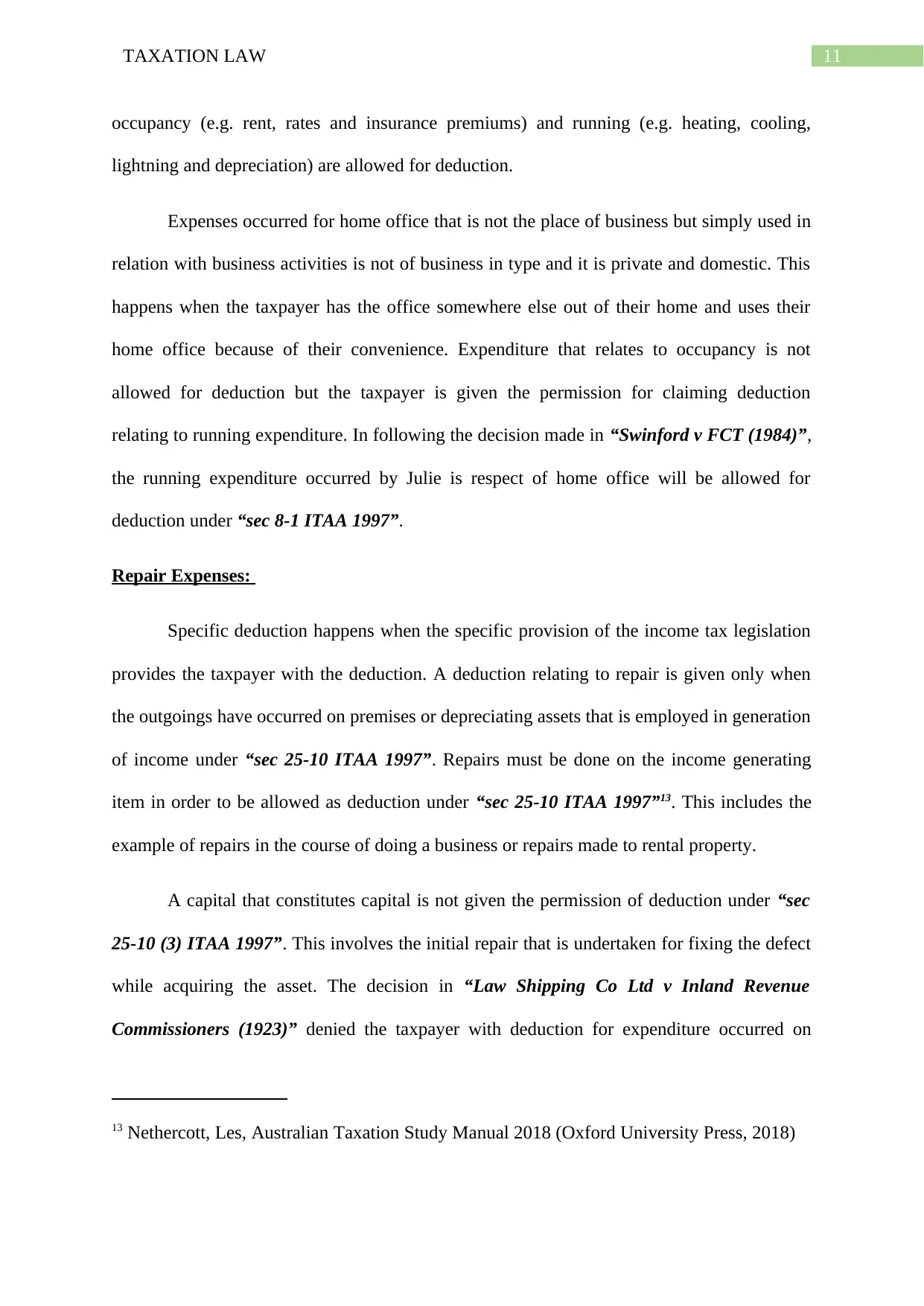
11TAXATION LAW
occupancy (e.g. rent, rates and insurance premiums) and running (e.g. heating, cooling,
lightning and depreciation) are allowed for deduction.
Expenses occurred for home office that is not the place of business but simply used in
relation with business activities is not of business in type and it is private and domestic. This
happens when the taxpayer has the office somewhere else out of their home and uses their
home office because of their convenience. Expenditure that relates to occupancy is not
allowed for deduction but the taxpayer is given the permission for claiming deduction
relating to running expenditure. In following the decision made in “Swinford v FCT (1984)”,
the running expenditure occurred by Julie is respect of home office will be allowed for
deduction under “sec 8-1 ITAA 1997”.
Repair Expenses:
Specific deduction happens when the specific provision of the income tax legislation
provides the taxpayer with the deduction. A deduction relating to repair is given only when
the outgoings have occurred on premises or depreciating assets that is employed in generation
of income under “sec 25-10 ITAA 1997”. Repairs must be done on the income generating
item in order to be allowed as deduction under “sec 25-10 ITAA 1997”13. This includes the
example of repairs in the course of doing a business or repairs made to rental property.
A capital that constitutes capital is not given the permission of deduction under “sec
25-10 (3) ITAA 1997”. This involves the initial repair that is undertaken for fixing the defect
while acquiring the asset. The decision in “Law Shipping Co Ltd v Inland Revenue
Commissioners (1923)” denied the taxpayer with deduction for expenditure occurred on
13 Nethercott, Les, Australian Taxation Study Manual 2018 (Oxford University Press, 2018)
occupancy (e.g. rent, rates and insurance premiums) and running (e.g. heating, cooling,
lightning and depreciation) are allowed for deduction.
Expenses occurred for home office that is not the place of business but simply used in
relation with business activities is not of business in type and it is private and domestic. This
happens when the taxpayer has the office somewhere else out of their home and uses their
home office because of their convenience. Expenditure that relates to occupancy is not
allowed for deduction but the taxpayer is given the permission for claiming deduction
relating to running expenditure. In following the decision made in “Swinford v FCT (1984)”,
the running expenditure occurred by Julie is respect of home office will be allowed for
deduction under “sec 8-1 ITAA 1997”.
Repair Expenses:
Specific deduction happens when the specific provision of the income tax legislation
provides the taxpayer with the deduction. A deduction relating to repair is given only when
the outgoings have occurred on premises or depreciating assets that is employed in generation
of income under “sec 25-10 ITAA 1997”. Repairs must be done on the income generating
item in order to be allowed as deduction under “sec 25-10 ITAA 1997”13. This includes the
example of repairs in the course of doing a business or repairs made to rental property.
A capital that constitutes capital is not given the permission of deduction under “sec
25-10 (3) ITAA 1997”. This involves the initial repair that is undertaken for fixing the defect
while acquiring the asset. The decision in “Law Shipping Co Ltd v Inland Revenue
Commissioners (1923)” denied the taxpayer with deduction for expenditure occurred on
13 Nethercott, Les, Australian Taxation Study Manual 2018 (Oxford University Press, 2018)
⊘ This is a preview!⊘
Do you want full access?
Subscribe today to unlock all pages.

Trusted by 1+ million students worldwide
1 out of 17
Related Documents
Your All-in-One AI-Powered Toolkit for Academic Success.
+13062052269
info@desklib.com
Available 24*7 on WhatsApp / Email
![[object Object]](/_next/static/media/star-bottom.7253800d.svg)
Unlock your academic potential
Copyright © 2020–2025 A2Z Services. All Rights Reserved. Developed and managed by ZUCOL.





